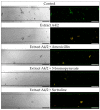Antibiofilm and Antimicrobial-Enhancing Activity of Chelidonium majus and Corydalis cheilanthifolia Extracts against Multidrug-Resistant Helicobacter pylori
- PMID: 34451497
- PMCID: PMC8400265
- DOI: 10.3390/pathogens10081033
Antibiofilm and Antimicrobial-Enhancing Activity of Chelidonium majus and Corydalis cheilanthifolia Extracts against Multidrug-Resistant Helicobacter pylori
Abstract
Helicobacter pylori is a Gram-negative bacterium that colonizes the stomach of about 60% of people worldwide. The search for new drugs with activity against H. pylori is now a hotspot in the effective and safe control of this bacterium. Therefore, the aim of this research was to determine the antibacterial activity of extracts from selected plants of the Papaveraceae family against planktonic and biofilm forms of the multidrug-resistant clinical strain of H. pylori using a broad spectrum of analytical in vitro methods. It was revealed that among the tested extracts, those obtained from Corydalis cheilanthifolia and Chelidonium majus were the most active, with minimal inhibitory concentrations (MICs) of 64 µg/mL and 128 µg/mL, respectively. High concentrations of both extracts showed cytotoxicity against cell lines of human hepatic origin. Therefore, we attempted to lower their MICs through the use of a synergistic combination with synthetic antimicrobials as well as by applying cellulose as a drug carrier. Using checkerboard assays, we determined that both extracts presented synergistic interactions with amoxicillin (AMX) and 3-bromopyruvate (3-BP) (FICI = 0.5) and additive relationships with sertraline (SER) (FICI = 0.75). The antibiofilm activity of extracts and their combinations with AMX, 3-BP, or SER, was analyzed by two methods, i.e., the microcapillary overgrowth under flow conditions (the Bioflux system) and assessment of the viability of lawn biofilms after exposure to drugs released from bacterial cellulose (BC) carriers. Using both methods, we observed a several-fold decrease in the level of H. pylori biofilm, indicating the ability of the tested compounds to eradicate the microbial biofilm. The obtained results indicate that application of plant-derived extracts from the Papaveraceae family combined with synthetic antimicrobials, absorbed into organic BC carrier, may be considered a promising way of fighting biofilm-forming H. pylori.
Keywords: 3-bromopyruvate; Bioflux; Helicobacter pylori; Papaveraceae; amoxicillin; bacterial cellulose; biofilm; flow system; sertraline; synergism.
Conflict of interest statement
The authors declare no conflict of interest.
Figures






Similar articles
-
Potential of Bacterial Cellulose Chemisorbed with Anti-Metabolites, 3-Bromopyruvate or Sertraline, to Fight against Helicobacter pylori Lawn Biofilm.Int J Mol Sci. 2020 Dec 14;21(24):9507. doi: 10.3390/ijms21249507. Int J Mol Sci. 2020. PMID: 33327555 Free PMC article.
-
Screening Papaveraceae as Novel Antibiofilm Natural-Based Agents.Molecules. 2021 Aug 6;26(16):4778. doi: 10.3390/molecules26164778. Molecules. 2021. PMID: 34443363 Free PMC article.
-
Antimicrobial and Antibiofilm Activities of Carvacrol, Amoxicillin and Salicylhydroxamic Acid Alone and in Combination vs. Helicobacter pylori: Towards a New Multi-Targeted Therapy.Int J Mol Sci. 2023 Feb 24;24(5):4455. doi: 10.3390/ijms24054455. Int J Mol Sci. 2023. PMID: 36901886 Free PMC article.
-
Synergistic Therapies as a Promising Option for the Treatment of Antibiotic-Resistant Helicobacter pylori.Antibiotics (Basel). 2020 Sep 30;9(10):658. doi: 10.3390/antibiotics9100658. Antibiotics (Basel). 2020. PMID: 33007899 Free PMC article. Review.
-
Fighting the Antibiotic Crisis: Flavonoids as Promising Antibacterial Drugs Against Helicobacter pylori Infection.Front Cell Infect Microbiol. 2021 Jul 20;11:709749. doi: 10.3389/fcimb.2021.709749. eCollection 2021. Front Cell Infect Microbiol. 2021. PMID: 34354964 Free PMC article. Review.
Cited by
-
Opportunities for Helicobacter pylori Eradication beyond Conventional Antibiotics.Microorganisms. 2024 Sep 30;12(10):1986. doi: 10.3390/microorganisms12101986. Microorganisms. 2024. PMID: 39458296 Free PMC article. Review.
-
The Antimicrobial Properties of Poplar and Aspen-Poplar Propolises and Their Active Components against Selected Microorganisms, including Helicobacter pylori.Pathogens. 2022 Jan 31;11(2):191. doi: 10.3390/pathogens11020191. Pathogens. 2022. PMID: 35215134 Free PMC article.
-
The effects and mechanisms of natural products on Helicobacter pylori eradication.Front Cell Infect Microbiol. 2024 Feb 28;14:1360852. doi: 10.3389/fcimb.2024.1360852. eCollection 2024. Front Cell Infect Microbiol. 2024. PMID: 38481665 Free PMC article. Review.
-
Anti-Helicobacter pylori and Anti-Inflammatory Sesquiterpenoids from the Rhizoma of Atractylodes macrocephala.Molecules. 2025 Jul 26;30(15):3142. doi: 10.3390/molecules30153142. Molecules. 2025. PMID: 40807315 Free PMC article.
-
Phillygenin Inhibits Helicobacter pylori by Preventing Biofilm Formation and Inducing ATP Leakage.Front Microbiol. 2022 Apr 28;13:863624. doi: 10.3389/fmicb.2022.863624. eCollection 2022. Front Microbiol. 2022. PMID: 35572695 Free PMC article.
References
-
- Hooi J.K.Y., Lai W.Y., Ng W.K., Suen M.M.Y., Underwood F.E., Tanyingoh D., Malfertheiner P., Graham D.Y., Wong V.W.S., Wu J.C.Y., et al. Global Prevalence of Helicobacter pylori Infection: Systematic Review and Meta-Analysis. Gastroenterology. 2017;153:420–429. doi: 10.1053/j.gastro.2017.04.022. - DOI - PubMed
-
- Megraud F., Bruyndonckx R., Coenen S., Wittkop L., Huang T.D., Hoebeke M., Bénéjat L., Lehours P., Goossens H., Glupczynski Y. Helicobacter pylori Resistance to Antibiotics in Europe in 2018 and Its Relationship to Antibiotic Consumption in the Community. Gut. 2021 doi: 10.1136/gutjnl-2021-324032. - DOI - PubMed
Grants and funding
LinkOut - more resources
Full Text Sources

